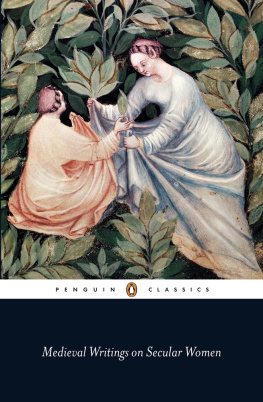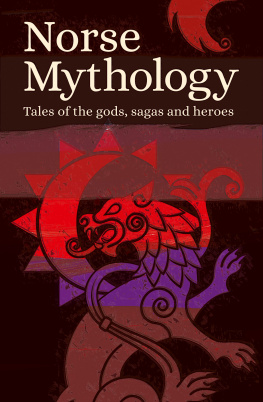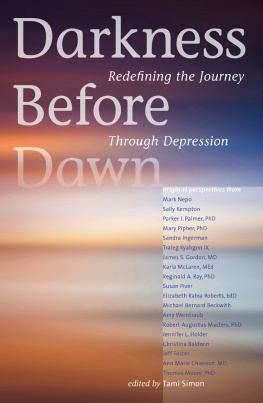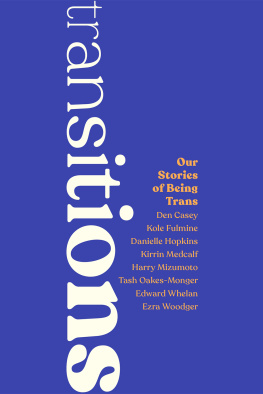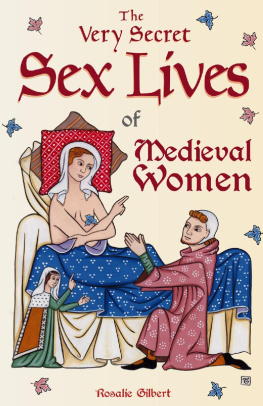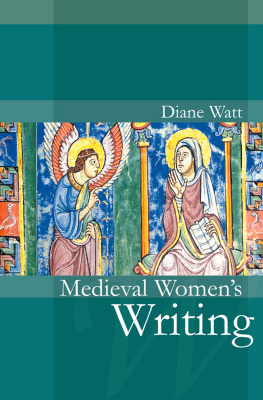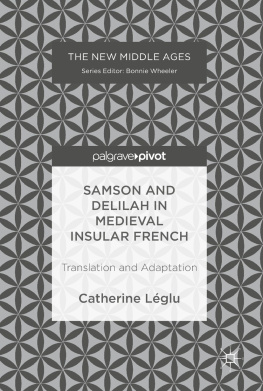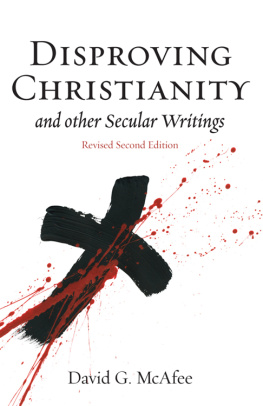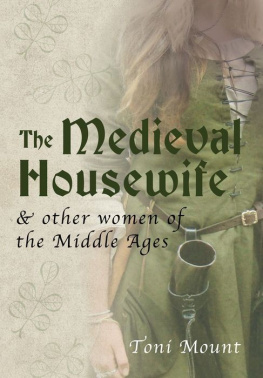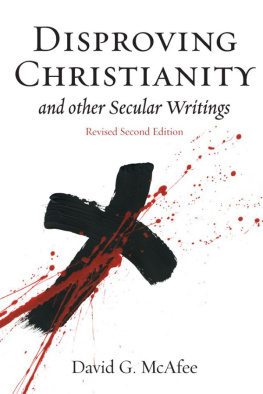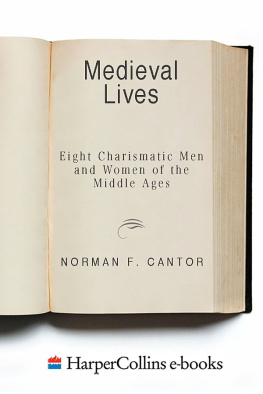Various Authors - Medieval Writings on Secular Women
Here you can read online Various Authors - Medieval Writings on Secular Women full text of the book (entire story) in english for free. Download pdf and epub, get meaning, cover and reviews about this ebook. year: 2011, publisher: Penguin Books Ltd, genre: Home and family. Description of the work, (preface) as well as reviews are available. Best literature library LitArk.com created for fans of good reading and offers a wide selection of genres:
Romance novel
Science fiction
Adventure
Detective
Science
History
Home and family
Prose
Art
Politics
Computer
Non-fiction
Religion
Business
Children
Humor
Choose a favorite category and find really read worthwhile books. Enjoy immersion in the world of imagination, feel the emotions of the characters or learn something new for yourself, make an fascinating discovery.
- Book:Medieval Writings on Secular Women
- Author:
- Publisher:Penguin Books Ltd
- Genre:
- Year:2011
- Rating:3 / 5
- Favourites:Add to favourites
- Your mark:
- 60
- 1
- 2
- 3
- 4
- 5
Medieval Writings on Secular Women: summary, description and annotation
We offer to read an annotation, description, summary or preface (depends on what the author of the book "Medieval Writings on Secular Women" wrote himself). If you haven't found the necessary information about the book — write in the comments, we will try to find it.
Medieval Writings on Secular Women — read online for free the complete book (whole text) full work
Below is the text of the book, divided by pages. System saving the place of the last page read, allows you to conveniently read the book "Medieval Writings on Secular Women" online for free, without having to search again every time where you left off. Put a bookmark, and you can go to the page where you finished reading at any time.
Font size:
Interval:
Bookmark:
Translated and with an Introduction by
PATRICIA SKINNER and ELISABETH VAN HOUTS
PENGUIN BOOKS
PENGUIN BOOKS
Published by the Penguin Group
Penguin Books Ltd, 80 Strand, London WC2R 0RL , England
Penguin Group (USA) Inc., 375 Hudson Street, New York, New York 10014, USA
Penguin Group (Canada), 90 Eglinton Avenue East, Suite 700, Toronto, Ontario,
Canada M4P 2Y3 (a division of Pearson Penguin Canada Inc.)
Penguin Ireland, 25 St Stephens Green, Dublin 2, Ireland (a division of Penguin Books Ltd)
Penguin Group (Australia), 250 Camberwell Road, Camberwell, Victoria 3124, Australia
(a division of Pearson Australia Group Pty Ltd)
Penguin Books India Pvt Ltd, 11 Community Centre, Panchsheel Park, New Delhi 110 017, India
Penguin Group (NZ), 67 Apollo Drive, Rosedale, Auckland 0632, New Zealand
(a division of Pearson New Zealand Ltd)
Penguin Books (South Africa) (Pty) Ltd, 24 Sturdee Avenue, Rosebank, Johannesburg 2196, South Africa
Penguin Books Ltd, Registered Offices: 80 Strand, London WC2R 0RL , England
www.penguin.com
First published 2011
Copyright Patricia Skinner and Elisabeth van Houts, 2011
All rights reserved
Except in the United States of America, this book is sold subject to the condition that it shall not, by way of trade or otherwise, be lent, re-sold, hired out, or otherwise circulated without the publishers prior consent in any form of binding or cover other than that in which it is published and without a similar condition including this condition being imposed on the subsequent purchaser
ISBN: 978-0-14-196869-8
PENGUIN  CLASSICS
CLASSICS
MEDIEVAL WRITINGS ON SECULAR WOMEN
ELISABETH VAN HOUTS is a Fellow and lecturer in Medieval History at Emmanuel College, Cambridge, with particular interests in the Anglo-Norman period, Latin historiography and the role of women in medieval society. Her books include The Gesta Normannorum Ducum of William of Jumiges, Orderic Vitalis and Robert of Torigni (19925); Memory and Gender in Medieval Europe9001200 (1999); History and Family Traditions in England and the Continent,1001200 (1999); Medieval Memories: Men, Women and the Past7001300 (2001); and The Normans in Europe (2000). She is currently preparing a book on the lay experience of medieval marriage.
PATRICIA SKINNER was Reader in Medieval History at the University of Southampton and now combines her continuing writing career with supporting researchers at the University of Portsmouth. She has published extensively on the social and gender history of medieval Italy, as well as editing books on Anglo-Jewish medieval history and medieval historiography. She is currently writing a book about Amalfi in the middle ages.
This book was conceived just after the second-millennium celebrations when the then editor of Penguin Classics, Laura Barber, suggested a twin volume to the Medieval Writings on Female Spirituality by Elisabeth Spearing. Both of us were immediately enthusiastic, because we realized that between us we could span a good selection of writings on secular women from the north and south of Europe. At the same time, we were apprehensive, in that as medievalists we were not trained Latinists (or for that matter translators of other medieval vernacular languages), so translating texts from scratch would be a daunting task. Any sense of burden, however, was soon lightened somewhat when we hit on the idea of using the female life cycle as a guiding principle. The speed with which we collected texts soon made it clear that by translating sections at a time we could manage to fit the workload into our busy professional and personal lives.
We are immensely grateful to a number of friends, colleagues and organizations for their generous permission to use their translations: Dr T. Hunt for . We thank all of them for their kind cooperation. Unpublished texts were most ). We benefited enormously from the advice on technical language (legal vocabulary) given by Professor Sir John Baker. Mrs Johanna Dale shared her expertise on images of medieval women with us, which allowed us to select the splendid picture of sage-collectors from the fourteenth-century Viennese Tacuinum sanitatis codex Vindobonensis, which is used for the front cover of our volume; we are indebted to her for her advice.
The editors and staff at Penguin have been an endless source of advice and support. In particular we owe a great deal to the encouragement of Alexis Kirchbaum and Rachel Love. Above all, we owe an immense debt to the care taken by Louisa Watson, our meticulous copy-editor.
Finally we should both like to thank our families and friends, who have lived with this project and provided valuable support and feedback since its inception.
Since research into medieval womens lives started in earnest nearly half a century ago, and has taken its place within academic curricula for at least the last forty years, one may wonder why it is that a new source book on the subject is required. but have rarely been examined in a comparative work.
This collection aims to juxtapose materials from various regions and periods in the Middle Ages. The earliest material presented dates to the ninth century, the latest, to the fifteenth. Geographically, the sources relate mainly to western Europe, with a rather higher proportion of southern European texts than is the norm for this type of collection. Inevitably, in a collaboration of this type, the regional bias of the sources unapologetically reflects the research interests of the two editors, but this is far from a parochial collection. We have grouped texts to enable comparisons across time and place to be made, and to provoke discussion about the validity of such comparisons. This does not imply that our purpose is to revive the old idea of a universality of experience among women, nor to suggest that a similar practice or custom in two separate parts of medieval Europe was as a result of one region influencing another (more likely these would be regions sharing a common legal culture stemming from the extensive Roman conquests and, where Rome had not penetrated, the later influence of Christianization). Simply put, this collection seeks to break down barriers: womens lives have often been studied along regional lines, and only more recent work has been ambitious enough to take a theme and study it across cultures. We hope that these extracts will provide more ideas for such comparison.
As well as the wide chronological and geographical span of our sources, they are also diverse in their typology, an issue which will be discussed in detail below. The major question which arose when we were compiling the collection was how to organize such a variety of material. In fact this diversity offered its own answer, as many sources were, ultimately, concerned with specific stages in the female life cycle, and thus provided a series of markers along the life journey which lent themselves to use as organizing milestones.
As a scheme, the life cycle is one that reflects current interests in womens and gender history. The seventeenth annual conference of the Womens History Network in Glasgow in 2008 was themed Gender and Generations: Women and Life Cycles, and covered all periods, not just the Middle Ages. Despite differences in class, religion, race, locality or time, womens life stages appear to provide a common thread that can be used to test those variables (although it is by no means unproblematic, as we shall see). To cite just one example, which will be elaborated on within the section on marriage below, it has long been known that the age of marriage for girls in elite households might be earlier than for those of lower social rank, but that northern Europe differed from southern Europe in this regard. Some women might therefore be widowed very early in their lives, and/or remarry several times. By placing sources about widows from different contexts alongside each other in this volume, we can see how these variances worked on the ground.
Font size:
Interval:
Bookmark:
Similar books «Medieval Writings on Secular Women»
Look at similar books to Medieval Writings on Secular Women. We have selected literature similar in name and meaning in the hope of providing readers with more options to find new, interesting, not yet read works.
Discussion, reviews of the book Medieval Writings on Secular Women and just readers' own opinions. Leave your comments, write what you think about the work, its meaning or the main characters. Specify what exactly you liked and what you didn't like, and why you think so.

